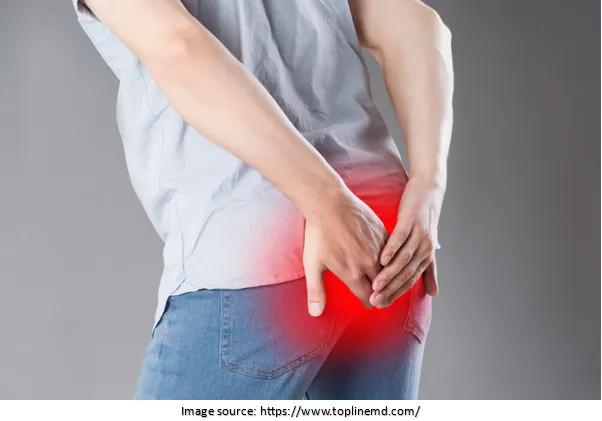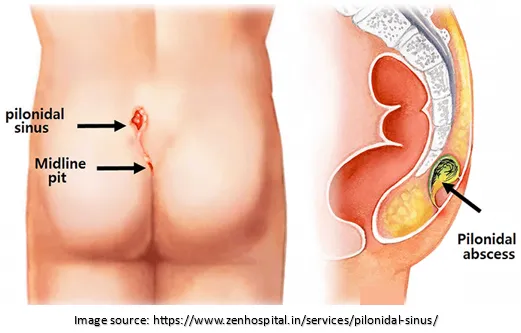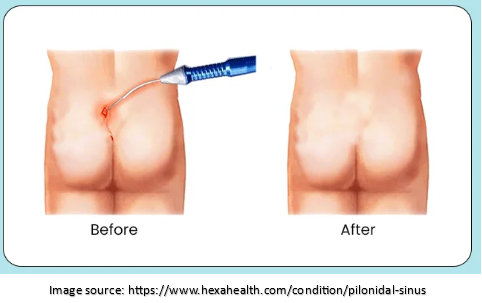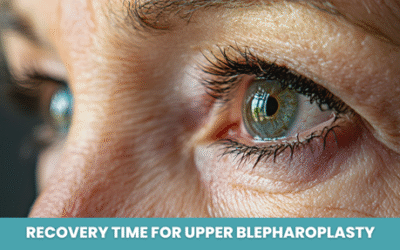
Pilonidal Sinus Treatment in Jaipur
 Pilonidal sinus is a common condition characterized by the development of a small hole or cavity in the skin near the tailbone. If left untreated, it can cause discomfort, pain, and recurrent infections. Fortunately, various treatment options are available to effectively manage and resolve this condition.
Pilonidal sinus is a common condition characterized by the development of a small hole or cavity in the skin near the tailbone. If left untreated, it can cause discomfort, pain, and recurrent infections. Fortunately, various treatment options are available to effectively manage and resolve this condition.
Individuals seeking pilonidal sinus treatment in Jaipur can expect comprehensive care, customized treatment plans, and access to modern surgical techniques at Rejuvena Cosmo Care.
Here, Dr. Deepesh Goyal offers various treatment options for pilonidal sinus, including advanced techniques such as pilonidal sinus laser surgery in Jaipur. He is a highly-qualified and skilled plastic surgeon in Jaipur, having expertise in pilonidal sinus excision, flap procedures and laser treatments, which promote faster healing and minimize the risk of recurrence.
As a trusted pilonidal sinus doctor in Jaipur, Dr. Deepesh Goyal ensures personalized care for each patient. He thoroughly evaluates the condition, discusses treatment options, and recommends the most suitable approach, depending on the severity of the case.
Whether you are experiencing the symptoms for the first time or seeking a long-term solution, this article will provide valuable insights into pilonidal sinus treatment.
First, let’s look at the,
Symptoms of Pilonidal Sinus
 Pilonidal sinus often presents with the following symptoms:
Pilonidal sinus often presents with the following symptoms:
- Pain and discomfort in the lower back near the tailbone area.
- Swelling, redness, or a small opening or pit in the skin near the tailbone.
- Drainage of pus or blood from the opening.
- Foul-smelling discharge.
- Itching or irritation in the affected area.
- Recurrent abscesses or infections.
Now, let’s know,
Contact us for more information or book an appointment
Causes of Pilonidal Sinus
The exact cause of pilonidal sinus is unknown. But certain factors may contribute to its development, including:
1. Hair growth: Hair follicles and loose hairs can penetrate the skin and cause inflammation.
2. Friction or pressure: Prolonged sitting, trauma, or irritation in the sacrococcygeal area can lead to the formation of a sinus tract.
3. Congenital predisposition: Some individuals may have a genetic tendency to develop a pilonidal sinus.
4. Poor hygiene: Lack of proper hygiene and cleanliness in the affected area can increase the risk.
Risks of Developing Pilonidal Sinus
Some individuals may be at a higher risk of developing pilonidal sinus, including those who:
1. Have a family history of the condition.
2. Have excess hair growth or thick, coarse hair.
3. Have poor hygiene practices.
4. Engage in activities that involve prolonged sitting or friction in the sacrococcygeal area.
Let’s discuss about,
Diagnosis of Pilonidal Sinus
The diagnosis of pilonidal sinus is typically made through a physical examination of the affected area. Here is an overview of the diagnostic process for pilonidal sinus:
1. Medical History: Your healthcare provider will begin by taking a detailed medical history, including any symptoms experienced, previous treatments or surgeries, and a family history of pilonidal sinus.
2. Physical Examination: The doctor will visually inspect the affected area, usually in the sacrococcygeal region near the tailbone.
They will look for the following signs:
- Presence of a pit or opening: Pilonidal sinus often presents as a small pit or dimple in the skin, which may contain hair.
- Inflammation or swelling: The area around the sinus may be red, swollen, or tender.
- Discharge or abscesses: Pilonidal sinus may have pus or blood draining from the opening, or there may be the presence of recurrent abscesses.
3. Digital Examination: In some cases, the healthcare provider may perform a digital rectal examination to assess the depth and extent of the sinus tracts. This involves inserting a gloved finger into the rectum to feel for any abnormalities or tunnels.
4. Imaging Studies: In some cases, the doctor may order imaging studies such as ultrasound or MRI to evaluate the extent and complexity of the sinus tracts, especially if the condition is recurrent or complicated.
Contact us for more information or book an appointment
Types of Treatment Options for Pilonidal Sinus
1. Wide Excision of Pilonidal Sinus:
This surgical procedure involves removing the sinus tract and any infected tissue. The surgeon may leave the wound open to heal through secondary intention or close it with sutures or skin grafts.
2. Laser Pilonidoplasty (LPP):

It is a minimally invasive procedure that uses laser energy to remove the sinus tracts and promote healing. It is associated with less pain, shorter recovery time, and reduced risk of complications compared to traditional surgery.
3. Excision with Primary Closure:
In this technique, the surgeon excises the sinus tracts and infected tissue and closes the wound with sutures or staples. This method provides immediate closure and faster healing but may have a higher risk of recurrence.
4. Z-Plasty:
It is a surgical technique used to reposition the wound edges in a zigzag pattern. It helps relieve tension in the wound and promotes better healing, reducing the chances of recurrence.

5. Cleft Lift/Modified Karydakis/Cleft Closure:
This pilonidal sinus surgery involves creating an incision in the midline of the buttock crease (natal cleft) and repositioning the skin flaps to close the wound. It provides an excellent cosmetic outcome and lowers the risk of recurrence.

6. Limberg Flap/Gluteal Flap:
This technique involves creating a flap of nearby healthy tissue and rotating it into the wound site to close the defect. It provides good wound coverage and reduces the risk of recurrence.
7. Advanced Laser Hair Removal:
Typically, doctors advise pilonidal sinus patients who travel or drive a lot and have hairy backs to get laser hair removal. These individuals are more likely to experience the onset of pilonidal sinus and its recurrence. Laser hair removal works as a permanent solution that inhibits hair growth.
It is important to note that the choice of treatment depends on the severity of the condition, the patient’s medical history, and the surgeon’s expertise.
Now, let’s know,
Contact us for more information or book an appointment
Cost of Pilonidal Sinus Treatment in Jaipur
In general, the cost of pilonidal sinus treatment may include the following:
- Pre-operative tests.
- Hospital charges (including room stay, operation theatre fees, and nursing care).
- Surgeon’s fees.
- Anesthesia charges.
- Medications.
- Follow-up visits.
- Any additional procedures or treatments required.
The cost may also vary for different treatment options, such as wide excision, laser pilonidoplasty, or flap procedures.
It is best to discuss the treatment plan and associated costs with your healthcare provider beforehand. They can provide a breakdown of the expenses and any available insurance coverage or payment options.
Additionally, it is crucial to consider the overall quality of care, the surgeon’s expertise, and the healthcare facility’s reputation when making a decision rather than solely focusing on the cost.
Here’s a table outlining the approximate costs of various pilonidal sinus treatments in Jaipur, India.
| Treatment | Cost Range (in INR) |
|---|---|
| Wide Excision of Pilonidal Sinus | 15,000 – 30,000 |
| Laser Pilonidoplasty (LPP) | 30,000 – 60,000 |
| Excision with Primary Closure | 20,000 – 40,000 |
| Z-Plasty | 25,000 – 50,000 |
| Cleft Lift / Modified Karydakis / Cleft Closure | 35,000 – 70,000 |
| Limberg Flap / Gluteal Flap | 40,000 – 80,000 |
Note: Please remember that these costs are only estimates and can vary based on several factors.
Pilonidal sinus can be challenging, but relief and healing are possible with the right treatment approach and proper care. Consulting with a healthcare professional is essential to determine the best course of action for your specific situation.
Remember, early diagnosis and treatment offer the best outcomes, so don’t hesitate to seek medical attention if you suspect you have pilonidal sinus.
Curious about the possibilities? Consult with Dr. Deepesh Goyal for your customized makeover plan.
FREQUENTLY ASKED QUESTIONS
Does pilonidal cyst surgery leave a hole?
Removing a pilonidal cyst or sinus may leave an open wound, especially if surgical excision is performed. Depending on the surgical technique employed, the wound may require healing by secondary intention or may be closed with sutures or flaps. Proper wound care is necessary for optimal recovery.
Can pilonidal sinus turn cancerous?
The pilonidal sinus itself is not cancerous. However, chronic inflammation and recurrent infections may increase the risk of developing squamous cell carcinoma, a type of skin cancer, in the affected area. This is a rare complication.
How long can the pilonidal sinus last?
Pilonidal sinus can persist for a prolonged period if left untreated or if recurrent infections occur. Timely treatment can help resolve the condition within a few weeks to months.
What is the success rate of pilonidal sinus treatment?
The success rate of pilonidal sinus treatment varies depending on the chosen treatment approach, the severity of the condition, and individual factors. Generally, the success rate is high, with a low recurrence rate if proper surgical techniques are employed.
Is pilonidal sinus a common condition?
Pilonidal sinus is relatively common, particularly in young adults. It is more prevalent in males than females.
Can pilonidal sinus be cured permanently?
While treatment can effectively manage pilonidal sinus, there is a risk of recurrence. However, the chances of permanent resolution are high with appropriate surgical intervention and good wound care.
Recent Posts
3 Days After Hair Transplant: Healing, Care & What’s Normal
A hair transplant is an exciting step toward achieving a fuller, more natural-looking head of...
Hair Transplant After 3 Weeks: Recovery, Results & Red Flags
A hair transplant is a life-changing procedure for many people looking to regain a fuller head of...
Recovery Time for Upper Blepharoplasty
Upper eyelid sagging is one of the most common concerns among men and women seeking eyelid...



